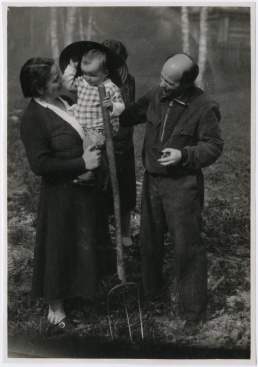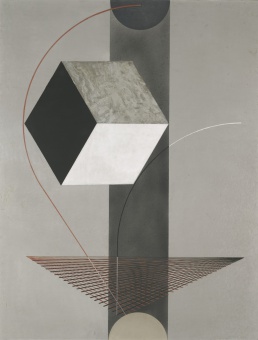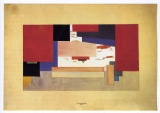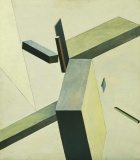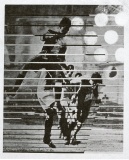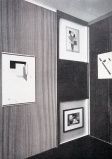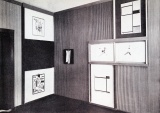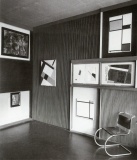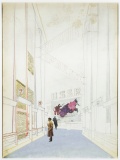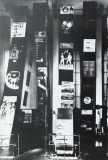Difference between revisions of "El Lissitzky"
| Line 58: | Line 58: | ||
** [http://rosswolfe.wordpress.com/2013/09/16/proun/ "Theses on the PROUN: From Painting to Architecture"]. | ** [http://rosswolfe.wordpress.com/2013/09/16/proun/ "Theses on the PROUN: From Painting to Architecture"]. | ||
* with Ilya Ehrenberg, [[Media:Lissitzky_El_Ehrenberg_Ilya_1922_Statement_by_the_Editors_of_Veshch.pdf|"Statement by the Editors of Veshch"]], 1922. | * with Ilya Ehrenberg, [[Media:Lissitzky_El_Ehrenberg_Ilya_1922_Statement_by_the_Editors_of_Veshch.pdf|"Statement by the Editors of Veshch"]], 1922. | ||
| − | * ''[[Media:Lissitzky_El_1923_Figurinenmappe_Sieg_ueber_die_Sonne.pdf|Figurinenmappe: Sieg über die Sonne]]'', 1923. [http://www.museum-digital.de/san/index.php?t=serie&serges=59] [http://www.dataisnature.com/?p=1907] [http://www.getty.edu/research/tools/guides_bibliographies/lissitzky/6_victory/index.html] | + | * ''[[Media:Lissitzky_El_1923_Figurinenmappe_Sieg_ueber_die_Sonne.pdf|Figurinenmappe: Sieg über die Sonne]]'', 1923. Drawings recasting the Russian Futurist opera ''[[Victory Over the Sun]]'' (1913/20) as an electromechanical show with mechanical puppets. [http://www.museum-digital.de/san/index.php?t=serie&serges=59] [http://www.dataisnature.com/?p=1907] [http://www.getty.edu/research/tools/guides_bibliographies/lissitzky/6_victory/index.html] |
* ''[[Media:Lissitzky_El_1923_1o_Kestnermappe_Proun.pdf|1o Kestnermappe Proun]]'' [Proun. 1st Kestner Portfolio], 1923, 6 plates. A suite of lithographic prints made as a New Year gift for members of the Kestner Gesellschaft, an independent society based in Hanover, which arranged exhibitions of contemporary art. Lissitsky had had a successful exhibition at the society early in 1923 and was commissioned to produce these prints. [http://www.museum-digital.de/san/index.php?t=serie&serges=61] | * ''[[Media:Lissitzky_El_1923_1o_Kestnermappe_Proun.pdf|1o Kestnermappe Proun]]'' [Proun. 1st Kestner Portfolio], 1923, 6 plates. A suite of lithographic prints made as a New Year gift for members of the Kestner Gesellschaft, an independent society based in Hanover, which arranged exhibitions of contemporary art. Lissitsky had had a successful exhibition at the society early in 1923 and was commissioned to produce these prints. [http://www.museum-digital.de/san/index.php?t=serie&serges=61] | ||
* with Hans Arp, ''Die Kunstismen/Les Ismes De L’Art/The Isms of Art: 1914-1924'', Erlenbach-Zürich/Munich/Leipzig: Eugen Rentsch, 1925, 46 pp. "Habe eine Idee für das letzte Merz-Heft 1924: 'Letzte Truppenschau aller Ismen von 1914-24'." schrieb El Lissitzky 1924 in einem Brief. Es gelang ihm, Hans Arp für diese Idee zu begeistern. The book gives definitions by well-known artists of the various movements, or forms of art, of the period. They range from Cubism, Futurism, Expressionism, Abstract Art, Metaphysicians, Suprematism, Simultanism, Dadaism, Purism, Neoplasticism, Merz, Proun, Perism, Constructivism, to Abstract Film. The definitions are followed by illustrations of examples of each movement. [http://brbl-dl.library.yale.edu/vufind/Record/3591747] [http://de.wikipedia.org/wiki/Die_Kunstismen] [http://www.lars-mueller-publishers.com/de/catalogue-art/die-kunstismen-1914-1924-reprint-1990] | * with Hans Arp, ''Die Kunstismen/Les Ismes De L’Art/The Isms of Art: 1914-1924'', Erlenbach-Zürich/Munich/Leipzig: Eugen Rentsch, 1925, 46 pp. "Habe eine Idee für das letzte Merz-Heft 1924: 'Letzte Truppenschau aller Ismen von 1914-24'." schrieb El Lissitzky 1924 in einem Brief. Es gelang ihm, Hans Arp für diese Idee zu begeistern. The book gives definitions by well-known artists of the various movements, or forms of art, of the period. They range from Cubism, Futurism, Expressionism, Abstract Art, Metaphysicians, Suprematism, Simultanism, Dadaism, Purism, Neoplasticism, Merz, Proun, Perism, Constructivism, to Abstract Film. The definitions are followed by illustrations of examples of each movement. [http://brbl-dl.library.yale.edu/vufind/Record/3591747] [http://de.wikipedia.org/wiki/Die_Kunstismen] [http://www.lars-mueller-publishers.com/de/catalogue-art/die-kunstismen-1914-1924-reprint-1990] | ||
Revision as of 19:55, 17 December 2013
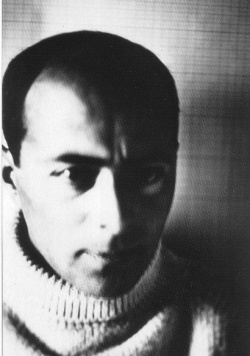 Self-Portrait, 1914. | |
| Born |
November 23, 1890 Pochinok, Smolensk Province, Russian Empire |
|---|---|
| Died |
December 30, 1941 (aged 51) Moscow, USSR |
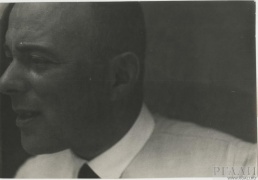
El Lissitzky was a Russian artist, designer, photographer, typographer, polemicist and architect. He was an important figure of the Russian avant garde, helping develop suprematism with his mentor, Kazimir Malevich, and designing numerous exhibition displays and propaganda works for the Soviet Union. His work greatly influenced the Bauhaus and constructivist movements, and he experimented with production techniques and stylistic devices that would go on to dominate 20th-century graphic design.
Contents
Life and work
Born Lazar Markovich (El) Lissitzky (Ла́зарь Ма́ркович Лиси́цкий) in 1890 to a Jewish family in Pochinok, Smolensk Province, Russia. 1903 takes lessons with the artist Iurii (Yehuda) Moiseevich Pen in Vitebsk. 1909 turned down by the St. Petersburg Academy of Art; enrolls as a student of architectural engineering at the Technische Hochschule in Darmstadt, Germany. 1912 travels in Germany, France, and Italy. 1914 returns to Russia during the summer, after the outbreak of World War I. 1915-16 works in various architectural offices in Moscow and St. Petersburg. 1916 receives a diploma in engineering and architecture from the Riga Technological University, which is temporarily quartered in Moscow; embarks on an expedition organized by the Jewish Historical and Ethnographic Society to explore the synagogues along Russia’s Dnieper River. 1917-19 lives and works in Kiev; participates in a national movement to revive Jewish cultural traditions for modern Russian Jews; designs Yiddish books, some for children. 1918 becomes a member of IZO Narkompros (Art Section of the People’s Commissariat for Enlightenment) in Moscow. 1919 in Kiev helps to found the Yiddish publishing house Kultur Lige, which becomes a leading force in the dissemination of Jewish culture in the Ukraine; in May invited by Marc Chagall to teach graphic arts, printing, and architecture at the People's Art School in Vitebsk; is introduced to Kazimir Malevich's system of nonobjective art, Suprematism, after Malevich arrives in Vitebsk in November to teach painting; works in the Suprematist collective UNOVIS (Affirmers of the New Art), along with Malevich and other artists; participates in decorating Vitebsk for the revolutionary holidays. 1920 invents the term Proun (Project for the Affirmation of the New) for his new form of abstract art. 1921 returns to Moscow; teaches architecture at the recently established art school VKhUTEMAS (State Higher Artistic and Technical Workshops); delivers a series of four lectures at INKhUK (Institute of Artistic Culture) on the topics of new art, Communism and Suprematism, monumental art, and the new city; travels to Berlin via Warsaw during the Fall on a mission to establish cultural contacts between Soviet and German artists. 1922 collaborates with the Russian writer Ilya Ehrenburg to produce the periodical Veshch. Objet. Gegenstand; meets the typographer Jan Tschichold; in May participates in the First Congress of Progressive Artists in Düsseldorf; in September takes part in the Congress of Constructivists and Dadaists in Weimar, where he meets the Dada artist Kurt Schwitters; in October meets Sophie Küppers, widow of Dr. Paul Erich Küppers, who had been the assistant to the director of the Kestner Society in Hanover; in December gives an important lecture in Berlin on Russian art. 1923 lectures on Soviet art in Rotterdam, Utrecht, and The Hague and at the Kestner Society; becomes seriously ill with tuberculosis and is treated in Switzerland; joins the editorial board of Hans Richter’s journal G and becomes a member of the De Stijl group; becomes a member of ASNOVA (Association of the New Architects), an organization founded in Moscow by Nikolai Ladovsky, Nikolai Dokuchaev, and Vladimir Krinsky, and assumes responsibility for developing connections with foreign architects. 1924 with Mart Stam and Emil Roth, edits the architectural review ABC: Beiträge zum Bauen; produces advertising designs for Gunther Wagner’s Pelikan office supply company; with the technical help of Roth, begins work on the Wolkenbügel (CloudIron), a horizontally expanding skyscraper intended for the Nikitsky Square in Moscow; in November the Swiss authorities turn down his request to renew his visa, but grant him a six-month extension "on humanitarian grounds." 1925 returns to Moscow in June. 1926 in January, appointed head of the Department of Furniture and Interior Design for the wood and metal workshop at VKhUTEMASl; in June, receives assignment from Narkompros to travel to Dresden, Rotterdam, Utrecht, Hamburg, and Lübeck to study modern architecture; commissioned by the directorate of the International Art Exhibition in Dresden to design the Room for Constructivist Art; returns to Moscow and, in collaboration with Ladovsky, publishes the single issue of the architectural review ASNOVA. 1927 marries Sophie Küppers on January 27; appointed chief artist for the All-Union Printing Trades Exhibition in Moscow; begins work on the design of the Abstract Cabinet for the Provinzialmuseum (Sprengel Museum) in Hanover. 1928 appointed chief artist for the Soviet Pavilion at the International Press Exhibition in Cologne; meets with Piet Mondrian, Fernand Léger, and Le Corbusier while on vacation in Austria and Paris. 1929 commissioned by the All-Union Society for Foreign Cultural Exchange to construct the Soviet Room at the Film and Photo Exhibition in Stuttgart. 1930 takes part in the competition to design the House of Heavy Industry; appointed chief artist for the Soviet Pavilion at the International Hygiene Exhibition in Dresden; commissioned to design the Soviet section at the International Fur Trade Exhibition in Leipzig; his son, Jen Lissitzky, is born on October 12. 1931 appointed chief architect for the Gorky Park of Culture and Rest in Moscow in March; Sophie’s older sons come to Russia to live with her and Lissitzky in the village of Khodnya, thirty miles from Moscow. 1932 signs his first contract with the editors of USSR in Construction, a Soviet propaganda publication intended for Western audiences and published in Russian, English, German, and French; becomes one of the principal artists for the journal, along with Aleksandr Rodchenko, Varvara Stepanova, and Solomon Telingater; designs seventeen issues, ten of them in collaboration with Sophie Küppers. 1934 appointed chief artist for the Agricultural Exhibition of the Soviet Union in Moscow. 1935-36 frequently hospitalized; convalesces in a sanatorium in the Caucasus. 1940 appointed chief artist for the Soviet Pavilion at the Belgrade International Exhibition, a project left unfinished due to the outbreak of World War II. 1941 works on anti-Nazi posters and other war-related projects until his death in Moscow on December 30.
Works
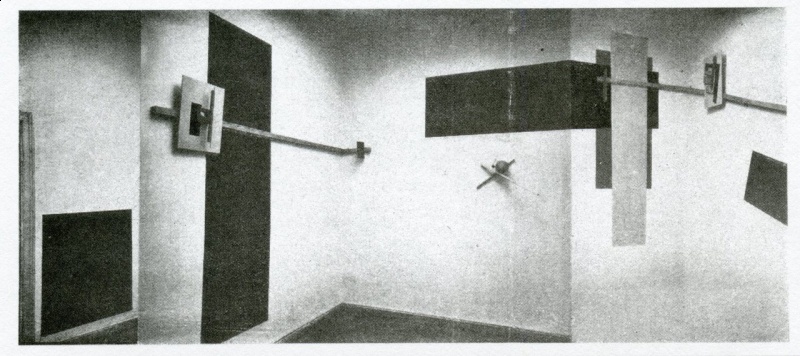
With Kazimir Malevich, Study for Backcloth for Vitebsk Committee for the Struggle against Unemployment, 1919.
Collections
Russian State Archive of Literature and Art (RGALI) in Moscow possesses the most extensive collection of Lissitzky's work. Its documentary holdings on Lissitzky include a photomontage; a plan of the first skyscraper in Moscow (1924-1928); a poster of Lenin; twelve experimental photos (1920s); photos of exhibitions in Berlin and Leipzig designed by Lissitzky; various articles; a notebook of Lissitzky's with sketches and miscellaneous notes; assorted letters to Lissitzky; his birth certificate, school diploma, contracts and applications; materials on his work with the Association of New Architects; individual photos of Lissitzky (between 1922-1935); group photos with others (between 1928-1934); and two photos of Gorky taken by Lissitzky in 1928. There is a searchable CD-ROM version (1996) of the seven-volume print guide to this collection.
The Lissitzky collection at Moscow's Tretyakov Gallery consists of drawings, watercolours, lithographs, archival documents, photographs, and examples of Lissitzky's original book designs and illustrations. Of the more than 300 items, outstanding examples include his variant designs for exhibition catalogues and periodicals; covers for film scenarios; sketches, drafts, and variants of his Prouns; watercolours and drawings of costume designs; and many sketches, studies, and preparatory materials for unrealized architectural projects and exhibition pavilions.
The Lissitzky collection at Van Abbe Museum in Eindhoven consists of 130 artworks (most of which came from the artist's studio in Hannover) and is the largest outside of Russia. The Museum also possesses several archival documents relating to El Lissitzky (postcards and letters, all to architect J.J.P. Oud, dating between April 28, 1923 and December 26, 1928).
The Busch-Reisinger Museum at Harvard University, Boston, has a moderately-sized collection (41 items) consisting of drawings (12), prints (21) and books (8), with a good number of Proun images.
The Sprengel Museum in Hannover has a small collection comprised of sketches and drafts for the Abstract Cabinet, several Proun lithographs, and a few entries by Lissitzky in the 84-page guestbook of Käte Steinitz, 1920.
Rijksbureau voor Kunsthistorische Documentatie in The Hague has letters from Lissitzky to the Dutch architect and artist Theo Van Doesburg, and from Lissitzky and Kurt Schwitters to Til Brugman (all dating between 1922 and 1926).
Fondation Le Corbusier in Paris has three letters from 1924 between Le Corbusier and Lissitzky.
Literature
By Lissitzky
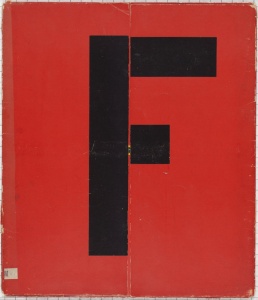
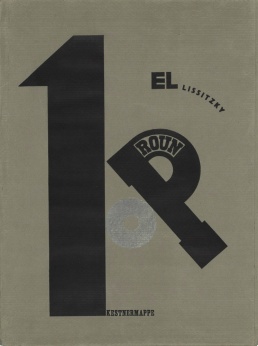
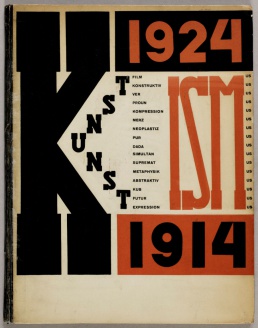
- "Suprematism in World Reconstruction", 1920, in John E. Bowlt (ed.), Russian Art of the Avant-Garde: Theory and Criticism, 1902-1934, Viking Press, 1976, pp 151-158.
- "Тезисы к ПРОУНу (от живописи к архитектуре)", 1920. (in Russian)
- with Ilya Ehrenberg, "Statement by the Editors of Veshch", 1922.
- Figurinenmappe: Sieg über die Sonne, 1923. Drawings recasting the Russian Futurist opera Victory Over the Sun (1913/20) as an electromechanical show with mechanical puppets. [2] [3] [4]
- 1o Kestnermappe Proun [Proun. 1st Kestner Portfolio], 1923, 6 plates. A suite of lithographic prints made as a New Year gift for members of the Kestner Gesellschaft, an independent society based in Hanover, which arranged exhibitions of contemporary art. Lissitsky had had a successful exhibition at the society early in 1923 and was commissioned to produce these prints. [5]
- with Hans Arp, Die Kunstismen/Les Ismes De L’Art/The Isms of Art: 1914-1924, Erlenbach-Zürich/Munich/Leipzig: Eugen Rentsch, 1925, 46 pp. "Habe eine Idee für das letzte Merz-Heft 1924: 'Letzte Truppenschau aller Ismen von 1914-24'." schrieb El Lissitzky 1924 in einem Brief. Es gelang ihm, Hans Arp für diese Idee zu begeistern. The book gives definitions by well-known artists of the various movements, or forms of art, of the period. They range from Cubism, Futurism, Expressionism, Abstract Art, Metaphysicians, Suprematism, Simultanism, Dadaism, Purism, Neoplasticism, Merz, Proun, Perism, Constructivism, to Abstract Film. The definitions are followed by illustrations of examples of each movement. [6] [7] [8]
- "A. and Pangeometry", 1925.
- "The Future of the Book", 1926. Trans. from New Left Review 41, 1967, pp 39-44.
- "Our Book", 1926. Trans. from Graphic Design Theory: Readings From the Field, ed. Helen Armstrong, Princeton, 2009, pp 25-31. Taken from El Lissitzky: Life, Letters, Text, ed. Sophie Lissitzky-Küppers, trans. Helene Aldwinckle and Mary Whittall, 1968.
- "Vicking Eggeling", Izvestiya Asnova 1, 1926.
On Lissitzky
- Books
- Sophie Lissitzky-Kuppers (ed.), El Lissitzky: Maler, Architekt, Typograf, Fotograf, Errinerungen, Briefe Schirften, Dresden, 1967. (in German)
- El Lissitzky: Life, Letters, Texts, London: Thames and Hudson, 1968.
- Margarita Tupitsyn, El Lissitzky: Beyond the Abstract Cabinet: Photography, Design, Collaboration, New Haven/London: Yale University Press, 1999, 239 pp.
- El Lissitzky: Jenseits der Abstraktion, Fotografie, Design, Kooperation, Munich: Schimer/Mosel, 1999, 239 pp. (in German)
- Nancy Lynn Perloff, Brian Reed (eds.), Situating El Lissitzky: Vitebsk, Berlin, Moscow, Getty Publications, 2003. [9]
- Nancy Perloff, "The Puzzle of El Lissitzky's Artistic Identity", pp 1-23.
- Christina Lodder, "El Lissitzky and the Export of Constructivism", pp 27-46.
- El Lissitzky. Wolkenbügel 1924-1925, Madrid: Editorial Rueda, Madrid, 2005, 152 pp. (in English/Spanish) [10]
- Catalogues
- El Lissitzky, Cologne: Galerie Gmurzynska, 1976.
- El Lissitzky, 1890-1941, Cambridge, MA: Harvard University Art Museums, Busch-Reisinger Museum, 1987.
- Book chapters, Papers, Articles
- Ernő Kállai, "Lissitzky", Das Kunstblatt 6:1, 1922.
- Door van den Eeckhout, "Lissitzky's electro-mechanisch amphitheater", Elsevier 38:76, (July-December 1928). (in Dutch)
- Franz Roh, Jan Tschichold (eds.), Foto-Auge / Oeil et Photo / Photo-Eye, Akademischer Verlag Dr. Fritz Wedekind, Stuttgart, 1929. [11] [12]
- Lucia Moholy, "El Lissitzky", The Burlington Magazine 108:756 (March 1966), pp 160-161+163.
- Alan C. Birnholz, "Notes on the Chronology of El Lissitzky's Proun Compositions", The Art Bulletin 55:3 (September 1973), pp 437-439
- Yve-Alain Bois, Christian Hubert, "El Lissitzky: Reading Lessons", October, Vol. 11, Essays in Honor of Jay Leyda (Winter 1979), pp 113-128.
- Lynn Gumpert, "El Lissitzky's Proun I. Kestnermappe", Bulletin, Vol. 2, 1979, pp 56-69. [13]
- Benjamin H. D. Buchloh, "From Faktura to Factography", October, Vol. 30 (Autumn 1984), pp 82-119.
- Esther Levinger, "El Lissitzky's art-games", Neohelicon 14:1, 1987, pp 177-191. [14]
- Esther Levinger, "Art and Mathematics in the Thought of El Lissitzky: His Relationship to Suprematism and Constructivism", Leonardo 22:2 (1989), pp 227-236.
- Manuel Corrada, "On Some Vistas Disclosed by Mathematics to the Russian Avant-Garde: Geometry, El Lissitzky and Gabo", Leonardo 25:3/4, Visual Mathematics: Special Double Issue (1992), pp 377-384.
- Victor Margolin, The Struggle for Utopia: Rodchenko, Lissitzky, Moholy-Nagy, 1917-1946, University of Chicago Press, 1998. [15]
- Paul Galvez, "Self-Portrait of the Artist as a Monkey-Hand", October 93, 2000.
- Igor Dukhan, "El Lissitzky: Jewish as Universal: From Jewish Style to Pangeometry", Ars Judaica, 2007, pp 1-20.
- John G. Hatch, "Some Adaptations of Relativity in the 1920s and the Birth of Abstract Architecture", Nexus Network Journal 12:1, 2010, pp 131–147.
- Theses
- Kemal Reha Kavas, Architectural Form Generation in Suprematist Painterly Space: The Significance of El Lissitzky's Prouns, Middle East Technical University, 2005, 120 pp. Master Thesis.
- Fabian Ziegler, El Lissitzky - Proun. Zur Logik der Form, Vienna: Vienna University, 2010, 132 pp. Master thesis. (in German)
See also
External links
- "Monuments of the Future": Designs by El Lissitzky (Getty Research Institute)
- Lissitzky's profile at Van Abbe Museum (in Dutch)
- Lissitzky at Google Art Project
- Lissitzky at The International Chamber of Russian Modernism, InCoRM (Patricia Railing)
- A selection of works by Lissitzky
- About 2 Squares by Lissitzky, 1922. [16]
- Models of Lissitzky's reconstructions of Malevich's figures from the Victory Over the Sun opera by Henry Milner, 2009.
- On Lissitzky's design for a yacht club on Lenin Hills, 1925.
- On Lissitzky's Abstract Cabinet, 1927-28.
- Lissitzky's Pelikan designs
- Lissitzky at Wikipedia
